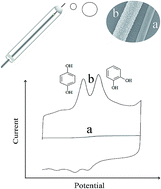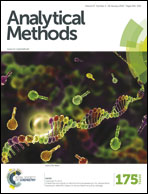A microsensor for hydroquinone and catechol based on a poly(3,4-ethylenedioxythiophene) modified carbon fiber electrode
Abstract
A rapid and highly sensitive miniaturized sensor for differential pulse voltammetry (DPV) and amperometric determination of hydroquinone and catechol based on a carbon fiber electrode modified by poly(3,4-ethylenedioxythiophene) was presented. This low-cost diphenol microsensor was constructed by several simple steps and displayed excellent electrochemical activity toward the oxidation of hydroquinone and catechol in 0.1 M phosphate buffer solution (pH 7.0). Furthermore, the microsensor had the virtues of good stability and high sensitivity. Under the optimal working conditions, linear relationships between the amperometric current response and the concentration of substrates were obtained in the ranges of 5.3 × 10−7 M to 8.6 × 10−4 M for hydroquinone and 5.2 × 10−7 M to 4.9 × 10−3 M for catechol, with the detection limits (S/N = 3) of 4.2 × 10−7 M and 1.6 × 10−6 M, respectively. The proposed microsensor was applied to the determination of the mixture of hydroquinone and catechol, and satisfying results were obtained.


 Please wait while we load your content...
Please wait while we load your content...